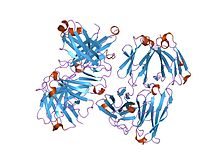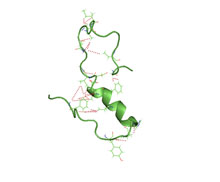Structural Biochemistry/Cell Signaling Pathways/RAGE: Pattern Recognition Receptor
Introduction[edit | edit source]
RAGE is a central signaling molecule found in the immune system and is involved in enduring and complicating responses toward inflammation. RAGE is also a receptor for products of glycation and acts as a pattern recognition receptor that recognizes common characteristics instead of specific ligands. New information about RAGE’s extracellular structure led to this discovery. Experimental procedures of x-ray crystallography and NMR show that ligand binding is driven by electrostatic interactions between ectodomains and ligands, which are positively charged and negatively charged, respectively.
RAGE and Inflammation[edit | edit source]

This receptor, RAGE, is part of a superfamily of cell surface receptors known as immunoglobulin (Ig). It is a major molecule in the development of severe chronic diseases including diabetes, inflammation, atherosclerosis, neurodegeneration and even cancer. Animals that are healthy have low expressions of the RAGE molecule but expression increases as the state of health or a disease worsens. Increased expression in the RAGE molecule also increases the expression of ligands attached to the RAGE molecule. Examples of RAGE ligands include AGEs, which are advanced glycation end products and members of the S100 protein family. AGEs are also part of many other groups including the high mobility group protein box-1 (HMGB1), β amyloids, and fibrous protein aggregates. Attachment of ligands to RAGE receptors activates various signaling pathways that depend either on the ligand, environment or cell type. These pathways can be:
- RAS-extracellular signal-regulated kinase pathways
- stress-activated protein kinase pathways
- p38 mitogen-activated protein (MAP) kinase pathways
- cAMP response to element-binding (CREB) protein
- activation of transcription family (STAT3)
When an inflammation response is in process, the RAGE-ligand attachment leads to an increase in the expression of the RAGE molecule. This is a type of positive feedback loop that results in prolonged activation of NF-κB, which is a nuclear transcription factor allowing for the conversion of a positive inflammatory response into a chronic physiological state. Researchers of this phenomenon realize that in order to prevent the RAGE molecule from inhibiting inflammatory responses, the positive feedback loop created by the RAGE-ligand and RAGE molecule, should be disrupted by blocking the receptor-ligand interaction site. However, this would require extensive knowledge of the mechanism of RAGE-ligand interaction.
Structure[edit | edit source]
X-Ray crystallography and NMR spectroscopy have allowed for studying the structure of RAGE as well as the mechanism of RAGE-ligand recognition. RAGE has a large positive surface charge allowing it to create electrostatic traps for ligands that have negative charges. The molecular organization of RAGE plays an important role initiating signals for ligand interaction. By studying fluorescence-labeled receptors, it was evident that RAGE did not exist as a single molecule in the plasma membrane of cells but collects in assemblies of receptors.
RAGE has a single transmembrane helix that connects the ectodomain with the short cytoplasmic domain and an extracellular component that is required for the ligand to recognize and bind. This extracullar component has three immunoglobulin-like (Ig) domains. The N-terminal Ig domain is assigned to the V-set of Ig-like molecules and is known as the V domain of RAGE. The other two Ig domains are part of the C1 and C2 set. The N-terminal V domain is located far away from the plasma membrane but the C2 domain lies close to the membrane. V and C1 domains can be joined together to form an elongated structure. V and C1 domains can be fixed and become the VC1 domain, which can connect to the C2 domain by several amino acids that have no secondary structure, which allows the VC1 and C2 domains to link. NMR spectroscopy studies have shown that VC1 moves as a single unit and can combine with the C2 domain.
The V domain consists a large amount of arginine and lysine, which carry positive charges at neutral pH. RAGE V domain has more arginine and lysine than the V-set of Ig domains. Arginine and lysine residues form large positively charged patches on the surface of V and C1 domains. Meanwhile, C2 domain has mainly acidic residues on its surface and is negatively charged. Because the two domains are oppositely charged, the extracellular component of RAGE is subdivided. This subdivision is reflected in the ligand binding properties of the different domains since ligands do not bind to C2 due to charge repulsion. Most ligands tend to bind to the V domain or the VC1 domain since ligands are negatively charged. There is only one case where a ligand has bound to the C2 domain. Nonetheless, charge-charge interactions are important for the formation of the receptor-ligand complex and suggested that the positively charged ligand-binding domain of the RAGE molecule can recognize certain arrangements of negative charges of ligands and can recognize these as common features for the ligands.
Receptor-ligand Interactions[edit | edit source]

Positron emission topography (in vivo) and in vitro have allowed for the study of binding of ligands. In vitro studies are conducted by monitoring the cellular response of RAGE ligands as well as protein-protein interactions. It was concluded that RAGE-ligand binding causes cells to respond immediately. Signaling of the ligand and its RAGE molecule increase in strength when the bonding affinity between the RAGE and ligand is high. The signal strength also increases when the signaling complex is activated for longer periods of time. There are two phases of the process of ligand binding. First, the dissociation phase reveals the lifetime of the signaling-competent complex. Ligands that dissociate slowly in vitro can induce longer and more intense receptor activations. Surface plasmon resonance (SPR) is a method for observing these activations since it examines the real-time interaction of the receptor, which can become immobilized and its ligand, which can bind. The thermodynamics of binding including the affinity of the RAGE-ligand attraction as well as the kinetics of the dissociations can be observed. The SPR technique has also revealed that multimeric, or consisting of multiple subunits, ligands have prolonged periods of binding to their receptors.
RAGE Ligands[edit | edit source]
Rage ligands are very diverse and have common features that allow for the activation of the RAGE molecule. The following are examples of RAGE ligands:
- AGEs (Advanced glycation endproducts)
These molecules are heterogeneous and are derived from the condensation and oxidation of proteins, peptides and sugars. The first step in forming AGE is the reaction of the aldehyde group of sugars with amine groups from lysine or arginine amino acids. This is a nonspecific and non-enzymatic process and it is called glycation. When glycation is high and frequent in individuals, it leads to diabetes and other complications. Oxidation of AGEs allows for the increase in overall negative charge on the ligand by carboxymethylation of the amino group. AGEs and RAGE have high affinities for one another and initiate a high level of endurance for pro-inflammatory responses. AGE and RAGE interaction has been observed as the main cause of diabetes complications and cardiovascular disorders.
- S100 Proteins
This family of proteins includes more than 25 members and each displays different patterns and functions. These proteins are small and acidic and have two different calcium bindings that are connected by a flexible loop. S100 proteins form homodimers and sometimes heterodimers and oligomers such as tetramers and octamers. S100 proteins can be found in vertebrates mainly and are localized in the cytoplasm, acting as calcium sensors. These proteins can display intracellular calcium signaling and binding that causes the S100 proteins to change in conformation and shape. In the extracellular space, S100 proteins are loaded with calcium since the calcium concentration is high, so they can bind to RAGE easily.
- Amyloid β and amyloid fibrils

Alzheimer disease is caused by the extracellular deposition of amyloid β peptide, originating from proteoloytic cleavage of amyloid precursor protein. Amyloid β peptides contains between 40 and 42 amino acids. These peptides have acidic and hydrophobic regions that are prone to accumulation of amyloid fibrils that build up amyloid plaques in the brain, causing Alzheimer’s disease. Mouse models of Alzheimer’s disease have shown that RAGE binds amyloid β and moves it around the blood stream to the blood-brain barrier in the central nervous system (CNS). Analyzing this using in vitro revealed that RAGE and amyloid β have high affinity for binding the soluble amyloid β peptide. RAGE can also bind amyloid fibrils.
- High mobility group box-1 protein (HMGB1)

This protein has an extracellular regulatory function and acts as a proinflammatory activator. HMGB1 has three domains: two N-terminus domains that are involved in DNA binding and one C-terminus domain that consists of various acidic amino acids as well as directs the binding to the RAGE molecule. HMBG1 binds to RAGE and Toll-like receptor 9 (TLR9), which forms the HMGB1-RAGE-TLR9 complex that activates B cells. DNA can bind with RAGE with high affinity and form a stable complex without the HMGB1 protein, but DNA-RAGE interaction has not produced noticeable results yet.
Ligands and their Common Features[edit | edit source]
RAGE can recognize common characteristics in different ligands. RAGE ligands have a net negative charge at their surfaces. They also usually have neutral pH, but S100 proteins have acidic pH. Also, AGEs do not usually have their surfaces negatively charged until they transform during glycation and oxidation. Most ligands also oligomerize. AGE modifies proteins, which leads to covalent bonds to higher molar mass molecules. S100 proteins also form large assemblies of tetramers or octamers.
Reference[edit | edit source]
Fritz, Gunter. RAGE: a single receptor fits multiple ligands. Trends Biochem Sci. 2011 Dec(12): 625-32. Epub2011 Oct19.